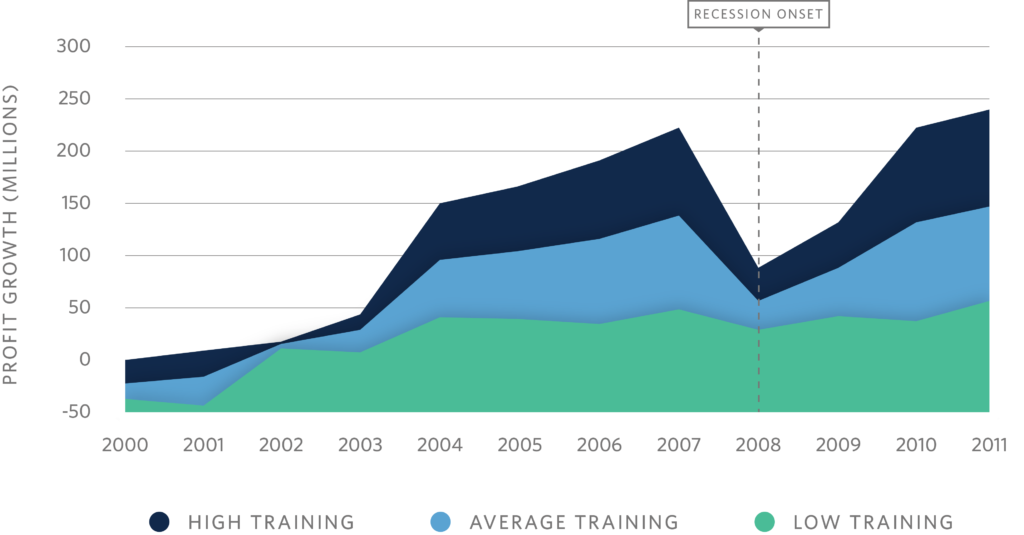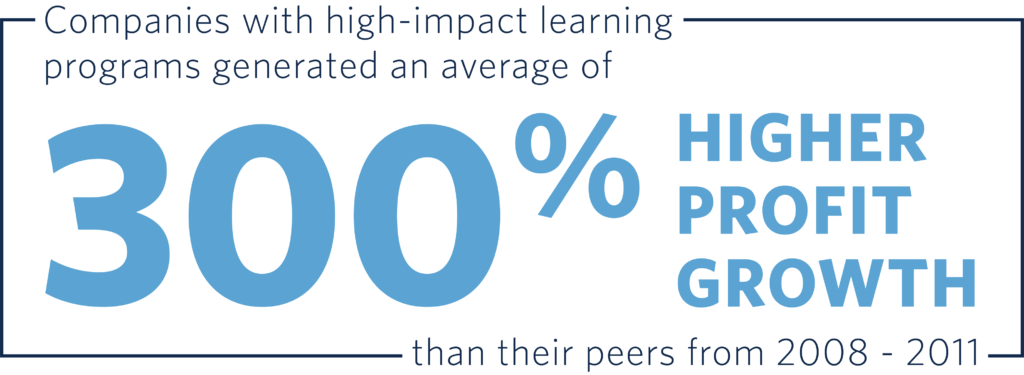Thought Leadership
Learning from the L&D Past in a COVID World

The COVID crisis has posed daunting challenges for learning and development (L&D) leaders. Many feel they don’t have a road map to find their way through a world that is suddenly filled with unexpected detours everywhere. Some face furloughs in their L&D teams, while others face pressure from leadership to drastically reduce L&D investments or to quickly make a compelling business case for keeping them.
In such times, lessons learned from L&D peers who experienced similar past recessions and unexpected shocks can help. What worked for them and what didn’t? What data shows how L&D decisions made during a crisis impact the bottom line?
This article shares insights and key takeaways from a number of UNC Executive Development’s directors who worked in corporate L&D during the 2008 financial crisis. They saw firsthand the business impact of continuing to invest in employee development – or cutting it – in tough times.
Beware Unintended Consequences
John Brothers, UNC’s executive director of design and client engagement, has lived through two crises as a consultant and as a corporate L&D leader – first 9/11 and then the 2008 financial crisis. During the financial crisis, Brothers led a talent management center of excellence with a Fortune 100 bank. “There was a lot of workforce uncertainty, anxiety and ambiguity during both crises, but having strong leadership really helped,” he says. “We had a strong history of growing, developing and challenging leaders. So when the 2008 crisis happened, they were able to meet the call. That experience helped provide stability and build trust for employees across the organization.”
The bank, however, also paused or cancelled development programs which had previously built a strong leadership pipeline. “The unintended consequences were that a lot of our people questioned where they would go in their career if the company wasn’t investing in them,” he says. “It led to reactivity instead of a growth mindset.”
Since Brothers was handling succession planning for a large part of the bank, there was a pressing need to focus on who they couldn’t lose. “We had to make sure we had a clear view on whom we needed to keep, how to keep them engaged and make sure they were in the right roles,” he says. “We had to focus on our HiPos and re-engage them in different ways to give them hope for the future.”
“That challenge will come up again. Companies will have to show what they value in terms of talent development and take a scalpel to their programs instead of an axe. Otherwise, people might vote with their feet, especially as tech transformation creates more opportunities. Be very purposeful about maintaining engagement of your top talent because there will be another side to this crisis and you need to be prepared for it.”
Unlike the 2008 crisis, Brothers noted that COVID-19 is transforming how business is conducted. “This will completely change the way we work and how we re-skill people to succeed in this new environment.” He advises L&D leaders to have a clear focus on top talent as they re-skill their staff to adapt to the unprecedented changes from COVID-19.
“Companies will quickly need to stabilize and establish where they go next. People development will be a key part of that. What’s different now is you need your people to rethink what you do and how you do it.”
Brothers’ cautionary examples can inform current L&D budget decisions. Understand that L&D investment helps prepare your leaders to handle future crises. L&D cuts can lead to attrition of top talent, so if programs have to be cut, cut carefully. Finally, be aware of what’s different this time: COVID is transforming the future of work, so your L&D programs need to focus on re-skilling top talent to think differently.
Anticipate and Communicate Business Impacts
A common organizational reaction to recessions is to pause almost all L&D activity. While that may help stop the bleeding in the short term, it can severely impact the company’s long-term success. “One common predicament is the lag between L&D budget cuts and the negative repercussions a company will see from that,” says UNC’s Anthony Laffoley, who worked in global training and development for a global consumer goods company during the 2008 crisis. “It is hard to measure the impact from those cuts because the lag time is so long.”

Indeed, a study of 359 companies, published in 2014 in the Journal of Applied Psychology, found that those which invested average or high amounts in their leadership development grew profits by approximately 200% after the 2008 crisis. Those which invested low amounts grew profits by just 50%. This disparity was also evident before 2008.
L&D leaders who are challenged by their C-suite to provide more evidence for investing in L&D can point to findings by leading HR organizations that clearly demonstrate the return on learning. According to research on over 2,500 firms by the Association for Talent Development, companies that invested in comprehensive training enjoyed 218% higher income per employee than those with lower training investments, and reaped a 24% higher profit margin. Additionally, a 2012 Bersin study found that companies with high-impact learning programs generated an average of 300% higher profit growth than their peers from 2008-2011.

Companies should also beware the costs of having to hire externally to fill key talent gaps caused by failure to invest in internal talent development. “Unfortunately we cut our investment in talent development and succession planning during the financial crisis,” Laffoley says. “The result is we had fewer internal candidates when we needed to fill a key position.” This isn’t an uncommon scenario. According to a 2015 study by The Conference Board and Development Dimensions International, only 15% of managers surveyed said their organization has a strong leadership bench. Laffoley says his company’s approach also had a negative impact on employee motivation as external candidates were hired. “Employee engagement took a hit.”
In a recession, L&D leaders often don’t get the direction from their organization’s C-suite that they previously received, which could be a good thing. “As executive attention is pulled away to more ‘business core’ critical matters, this may provide an opportunity for more empowered decision-making,” Laffoley says. “The L&D leader can feel frustrated, or use this as a chance to take the initiative, communicate up, and be more decisive. Focus on what you can control. Positively interpret the lack of direction as empowerment to make your own decisions.”
One approach Laffoley found effective as an L&D leader during the 2008 crisis was to listen more. “Rather than focusing on what communications need to be pushed out, increase the vehicles by which employees feel heard. This is always important, and it seems to be valued even more during difficult times.”
He also notes that L&D budget cuts can offer an opportunity to test assumptions about a wide variety of topics, from how effective certain learning technologies can be to how contracts with learning vendors must be structured. “Embrace this challenge as an opportunity to innovate new solutions you might have thought impossible previously.”
Laffoley’s experiences, backed by independent research, arm L&D leaders with data-driven arguments that investing in L&D can have big impacts on your company’s bottom line and on your succession planning. And his advice that L&D leaders should empower themselves to act when direction from above is absent and to solicit input from the field provides a useful map to those feeling uncertain on what to do in this crisis.
Get Your House in Order
UNC’s Heather Freeland also lived through 9/11 and the 2008 financial crisis as a corporate L&D leader.
During the financial crisis, Freeland was a senior VP for leadership development for a top bank. Given the bank’s focus on efficiency during the crisis, and resulting government oversight, her team concentrated on ensuring that their internal processes such as talent planning, training assignments, and performance feedback and reviews were made simple and easy to execute. “We had to make sure our internal work was flawless so that we didn’t take up our leadership’s time on inefficient or inaccurate instructions or activities,” she says.
“During both crises, our focus was on supporting our executive leadership’s messaging to their teams in terms of providing reassurance, focus, and direction” Freeland reflects. “A lot of our time was spent helping them prepare these communications and coaching and advising them. With my team of direct reports, I did the same thing – communicating what we knew, where we were still putting focus and energy, and how to support the leaders they were aligned with.”
L&D leaders may benefit from Freeland’s advice to seize this opportunity to make internal L&D processes more efficient and to position themselves as an invaluable asset to C-suites who need help communicating up, down, and across their organization.
Anticipate the Big Shifts
UNC’s Ed Franzone, who led L&D for a major healthcare company during the 2008 crisis, faced several challenges. They included reduced support staff, with senior L&D leaders required to take on tactical work that junior staff had handled, and doing more with fewer resources. Budget reductions also forced a shift to more scalable learning approaches. “Some of them worked well, some didn’t,” he says. “You have to be aware of the ultimate cost of the choices you make.”
Franzone’s company made the decision to differentiate, for the first time in its history, between high-potentials and the general employee population. “In an environment where resources are limited, it is critical to differentiate where you invest your L&D dollars,” he reflects. “Because this high-potential population was critical to the organization’s succession plan and business performance, we began investing disproportionately in them. As a result, we offered them unique learning experiences with leading business schools and consultancies in various regions around the world.”
Due to a large percentage of investment being targeted at HiPo development, his company had to implement cost-effective, scalable online learning solutions for the general employee population. “Traditionally, the L&D organization delivered 100% of their learning experiences via in-person instructor-led training,” says Franzone. “The introduction of self-paced, just-in-time learning was new and counter-cultural. Making this shift required a thoughtful change management effort to get employees to embrace this new approach.”
While his company had a rich history of leveraging leaders as teachers in the classroom, the 2008 crisis required them to focus on their core duties. “Consistent with our approach of differentiating where we invested our L&D dollars, leveraging senior leaders became most prevalent in our programs for HiPos,” Franzone says. “Further, instead of having leaders facilitate entire workshops, we began to use them more strategically as speakers, mentors, authors of mini-case studies and sponsors of action learning projects.”
Due to tight budgets and travel restrictions, Franzone’s team improvised, designing programs for local implementation by regional leaders. “The L&D function, based in headquarters, delivered what we called ‘training in a box’ for our regional leaders (e.g., region president, country leader and/or HR leader). We collaborated with them to customize the content and provided train-the-trainer sessions to accelerate their readiness to lead the programs.”
The lessons Franzone learned during the 2008 crisis are relevant today as we work through challenges of COVID-19. Aligning your L&D strategy with your organization’s needs and culture and paying attention to change management are critical to navigating today’s environment. Make your innovation iterative and do not let the desire for perfection get in the way of making progress.
The Way Forward
In the whirlwind of uncertainty created by COVID-19, we offer these lessons learned and insights from your peers to arm you with actionable insights and data when your company is making hard choices about human capital investments. If you’d like to talk to our leaders about these or other challenges you’re facing, we welcome a discussion. UNC Executive Development takes a collaborative approach in co-designing solutions with our clients to address their biggest challenges. Get in touch with us.